Now join your hands, and with your hands your hearts.
William Shakespeare, Henry VI, Part III
Flashback to Sharpie Towers a few years ago, when my lovely husband and I found ourselves looking forward to a significant wedding anniversary. Our tenth to be precise. This may seem quite a short period of time to some of you Puffins, but we were not exactly in the initial flush of youth when we met, and it wasn’t a first marriage for either of us. Perhaps that had a bearing on us thinking that celebrating a decade of married bliss sounded really rather special.
We are both pretty keen on art and have collected an eclectic variety of artwork (some might say junk) over the years, from ceramics to glass, watercolours to oils, textiles to wood, and more. This includes sculpture, so we were keen to explore what could be achieved to mark our special occasion with something permanent that we could enjoy for years to come, rather than just an ephemeral ‘trip away and a nice meal’ celebration. We eagerly looked up the material associated with ten years of marriage, and found that it is… just plain old tin!
Oh, that was not really the romantic substance we had expected. Somehow, exchanging a can of Heinz 57 wasn’t quite what we’d had in mind.
We looked at artwork made from tin, sculpture mostly, but we didn’t see anything that we could afford which seemed just right. But what could we do instead? We started thinking about other ways to mark this event, looking at different types of art for inspiration. We considered a having a portrait painted, or a glamorous photo shoot, but neither of us popped out of the top drawer—we’re a couple of council house kids, and that isn’t really us.
Then we stumbled across bodycasting, or lifecasting as it’s also called. We first saw a series of photographs where a nubile young lady’s torso or bottom had been cast. I have to admit that this wasn’t really our thing, not least because age brings along more and more odd saggy or wobbly bits with each passing year! Get real—would you really want those captured for posterity? They also take up rather a lot of space.
However, somewhere along the line we remembered that we’d seen a beautiful bronze of the poet Elizabeth Barrett Browning’s hand, holding the hand of her husband and fellow poet Robert Browning.
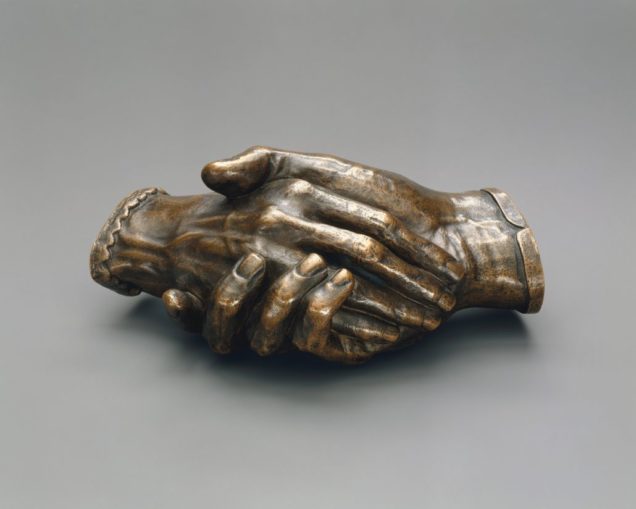
© Harriet Goodhue Hosmer, CC0 1.0 Universal Public Domain Dedication
The Barrett Brownings were a wonderfully romantic couple, courting and marrying in secret, even though Elizabeth was aware that this meant she would be disinherited by her disapproving father. Indeed, it was Elizabeth who wrote a love sonnet with which many of you will be familiar:
How do I love thee? Let me count the ways.
I love thee to the depth and breadth and height
My soul can reach, when feeling out of sight
For the ends of Being and Ideal Grace.
I love thee to the level of everyday’s
Most quiet need, by sun and candlelight.
I love thee freely, as men strive for Right;
I love thee purely, as they turn from Praise;
I love thee with the passion put to use
In my old griefs, and with my childhood’s faith;
I love thee with a love I seemed to lose
With my lost saints,—I love thee with the breath,
Smiles, tears, of all my life!—and, if God choose,
I shall but love thee better after death.
Doubtless, in these enlightened days though, the couple are no longer PC nor acceptable. It may be verboten to even speak their names, as both Robert’s and Elizabeth’s families had links with slavery in the West Indies. Far more important than focusing on talent, eh?
Still, very appropriate for an anniversary, we thought. The idea of capturing our own precious and very personal moment in time with a cast of our linked hands appealed to us both. Casting a one-off bronze is very expensive, even for a relatively small piece, so this would be out of the question. However, bronze resin should be well within our price range.
Although we thought a bronzed appearance would be good, we also considered other finishes for the resin, more like natural stone. As marble is a traditional medium for sculpture, its use dating back to ancient Mesopotamia where it was used to sculpt animal models before reaching its pinnacle in ancient Greece, we wondered whether that slight translucency might be a better choice.
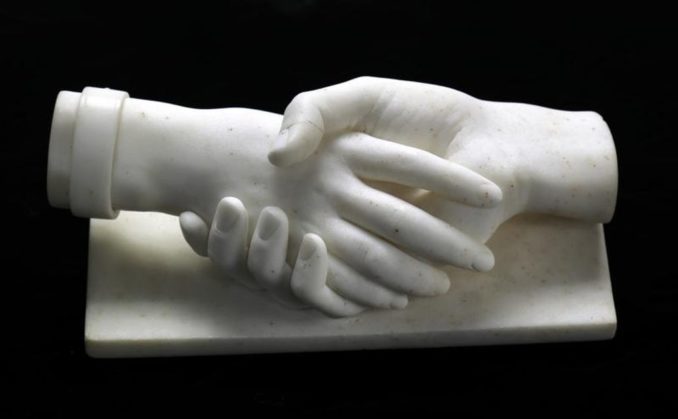
© John Adams Jackson, CC0 1.0 Universal Public Domain Dedication
We did rather favour that, but the more we thought about it, the more we felt that we weren’t keen on our hands simply cutting off at the wrist (a little too reminiscent of ‘Thing’ from The Addams Family, perhaps) so we came up with the idea that we would hold hands in an upright position.
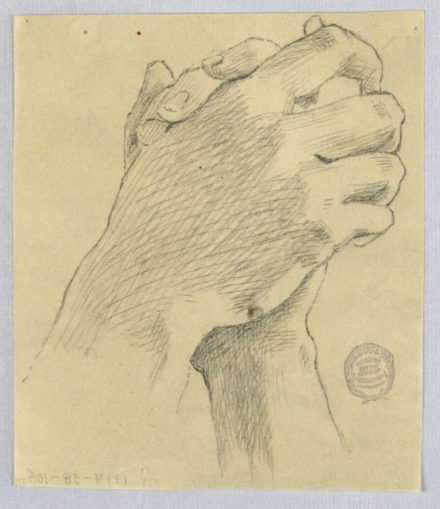
© Francis Augustus Lathrop, CC0 1.0 Universal Public Domain Dedication
We had a rough plan, so started searching and found several artists who could potentially make what we wanted, although none of them was nearby. Judging by their websites, there wasn’t a massive variation in price but there did seem to be a big difference in approach. In the end, we decided to contact a sculptor called Tony Meadows, whose website was straightforward with no great sales pitch and this made us feel comfortable.
A super chap, and extremely talented. We discovered that Tony had been involved in the arts for over 40 years, and he’s still working today. He has a Farcebook page where his most recent work can be found: @LifecastAndSculpture
Originally he worked as a painter (in both oils and watercolour), he’s also a skilled etcher, wood engraver and illustrator. His work has featured at The Royal Academy Summer Exhibition, Royal Institute of Painters in Watercolours, Royal Society of Miniature Painters, Sculptors and Gravers, and he’s had several solo exhibitions. A self-confessed curmudgeon, more recently his subjects have included social comment and satire on the stupidities of the fools and politicians who lie to us. Definitely our sort of bloke.
His studio is based near Moelfre, just over the border into Wales, a few miles from Oswestry. This is an area we love, so we were more than happy to travel to see him once we’d had a chat. We rang him to discuss what we were looking for. He sounded lovely, and he made several very sensible and practical suggestions ahead of our visit.
Originally, we had thought we’d like to have our hands sculpture mounted on a wooden plinth. This was certainly possible and Tony talked us through the options. A straight-grained, creamy-white Common Ash (Fraxinus excelsior) plinth sounded as though it would suit us nicely.
As well as being beautiful, Ash wood is very dense and strong, and has a range of excellent properties. Traditionally, Ash trees were coppiced for firewood as the wood burns well, even without being dried. A resilient wood too, it was used for making longbows, and is still used to make tool handles. Hockey sticks, oars, snooker cues and similar sporting equipment, such as hurleys, are made of Ash, indeed Irish sports writers sometimes refer to ‘the clash of the ash’ when describing the thrills of hurling. The wood is also a particularly good shock-absorber, so to this day it is used for the frames of Morgan cars.
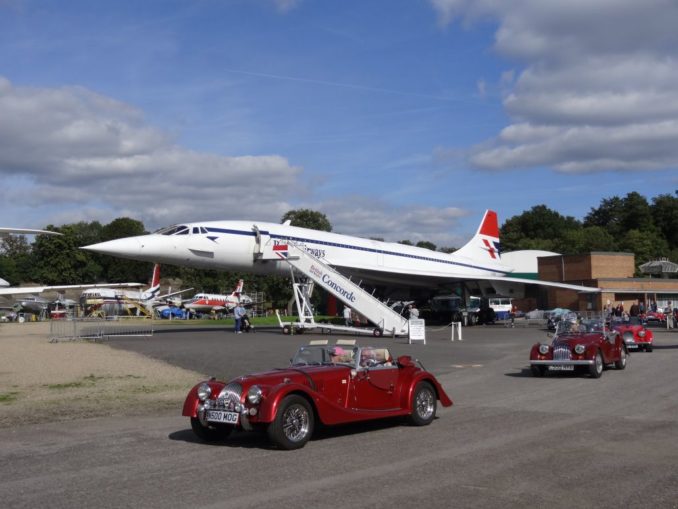
© John K Thorne, CC0 1.0 Universal Public Domain Dedication
On a slightly more mystical note, I was rather taken by the idea that in Norse mythology the ‘tree of life’ or ‘world tree’, Yggdrasil, is a huge Ash. This tree was believed to embody the entire cosmos, connecting and sheltering the nine realms and supporting the universe. Very Pratchett-esque. Who wouldn’t appreciate a plinth with such romantic connections?
Perhaps of greater interest, since this is Going Postal, is that more than one award-winning beer has been named after this mythical Norse Ash tree. The Wacken Brewery in Germany produce their ‘Yggdrasil’ as a 5.3% ABV Nordic Red Ale, brewed in the Irish red ales tradition (this won Gold in the Meininger’s International Craft Beer Award 2019).

© 5snake5, CC0 1.0 Universal Public Domain Dedication
Closer to home, the Edinburgh-based Black Metal Brewery also offer a Silver Award-winning Strong Pale Ale called ‘Yggdrasil’. At 6.6% ABV, it’s an unfiltered, burnt-orange strong beer, described as hoppy and bitter like an Imperial IPA. Both of these brews sound worth a try.
How beer has all that much to do with Ash trees escapes me, although there is a traditional French drink called ‘Ash Beer’ or ‘Frênette’. Mildly alcoholic, this is brewed from Ash leaves which have been munched-upon by aphids. The fermenting sugars come from the sap exuded from the damaged leaves and also from the sugar-rich sticky honeydew secreted by the aphids. Hmmm, I might just give that one a miss.
Moving back to the sculpture, although the Ash plinth sounded like the perfect one for us, Tony dropped into the conversation that an upright ‘hands’ piece could be made so it was wall-mountable rather than sitting on a plinth. Oh! We hadn’t even considered that. We scratched our heads and pondered, and looked around our already crowded flat and realised that this sounded like a much more practical idea. Well, there goes the Ash and its mystical connections. Disappointing in some ways, but it made a lot more sense.
We set a date to travel up to Moelfre to meet Tony, discuss the last few final details and have our hands immortalised in Jesmonite (a gypsum-based material, basically plaster of Paris in an acrylic resin). Before we set off, we practised putting our hands in various poses and settled on what we felt we could sustain comfortably for around 30-40 minutes—you need to stay completely still for quite some time for the alginate, then the plaster shell to set. We were surprisingly apprehensive.
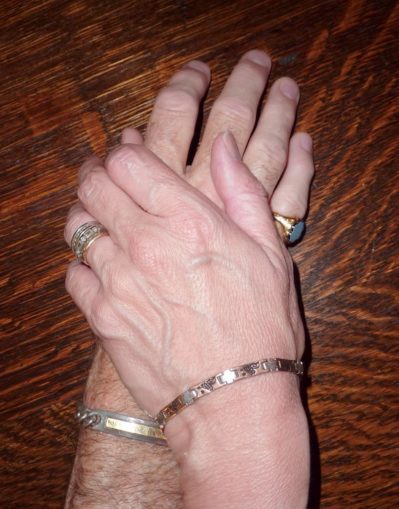
© SharpieType301 2013
When we arrived, Tony and his lovely wife Dawn made us welcome, made us tea, and showed us into the conservatory where a large table, covered in heavy plastic (it’s a messy process!), was set up and ready to go. First, we talked about the pose we’d chosen, and Tony gently introduced a few minor adjustments which would be more aesthetically pleasing and probably also be more comfortable. Definitely an expert, so his advice was gratefully accepted. Next came a decision about jewellery, but first a bit of explanation.
The mould-making is the most important stage—from the mould the final cast is made. The moulding material used here is alginate, a water-based colloidal suspension of a polysaccharide extracted from brown marine algae (a.k.a. kelp, or seaweed) and salt of alginic acid, a linear polymer of mannuronic and glucuronic acids, found in the cell walls of algae. Used for dental impressions, it’s a gloopy, gelatinous liquid. It’s completely safe, hypo-allergenic, doesn’t get hot when setting and doesn’t stick to the skin. When removed the surface of the alginate will have captured every detail of the hands, right down to the wrinkles (yep, we’ve got a few) and individual hairs.
To make a mould, the alginate is liberally dolloped [technical term] onto the hands, ensuring both hands are completely coated, and then it’s left there until it has set. In setting, it gradually changes from a viscous liquid to a rubbery solid.
That’s stage one, but since alginate is incredibly flexible once it has ‘set’, floppy almost, layers of plaster of Paris and bandages are applied to create a nice hard shell around the outside of the alginate mould. This helps to keep the shape intact when the hands are wiggled and pulled out of the mould, to leave a perfect 3D negative of your hands in the alginate.
This is where there’s a possible problem with jewellery. In theory, it should be fine, but there’s a small chance that precious stones may be pulled out of ring settings or that bracelets may snap with the force of removing them from the set alginate. We decided against risking the bracelets, and the most delicate of my rings, but we wanted to include my wedding and engagement rings and my husband’s signet ring.
So, that sorted out, hands palm down on the table, we assumed the position! Tony started dolloping the alginate over our hands and, dammit, this stuff’s cold. I’d hate to have decided on a full torso cast. It’s at this point that you do not want to realise that you should have popped to the loo before we started—from here on you need to keep very, very still.
The occasional prod from Tony told him when the alginate was pretty much set and it was time for stage two—to make the plaster cast. Think ‘The Curse of the Mummy’s Tomb’, as layer upon layer of plaster and bandages gradually built up a protective shell around the blue alginate. At around an inch thick, this takes rather longer to set and harden.
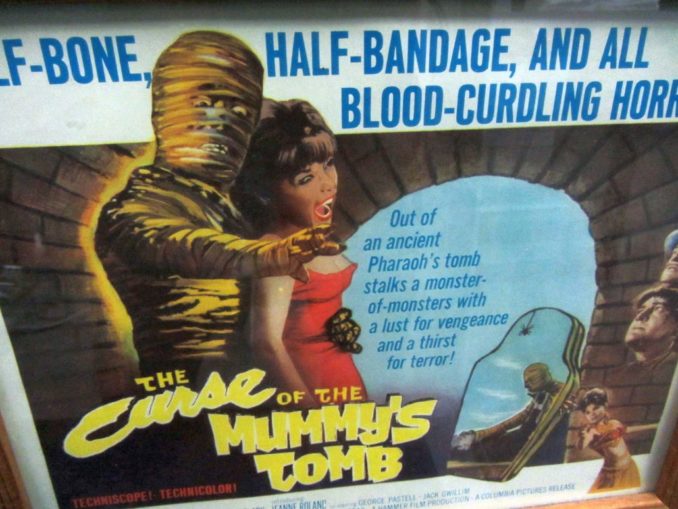
© Bob Bekian is licensed under CC BY-SA 2.0
The next part of the process was to extract us from the mould. One at a time we gradually wriggled our way out of the cold clutches of the big blue rubbery beast, being careful not to waste all this precious time by being too rough. Tony guided us all the way, making suggestions now and again to help us escape without causing any damage. I’m quite glad I don’t have hairy forearms, my husband wasn’t quite so fortunate!
Then, ta dah! The mould is turned over like a turtle in its shell and, turning our heads this way and that, with Tony’s help we can sort of make sense of the impressions and figure out which finger belongs to who.
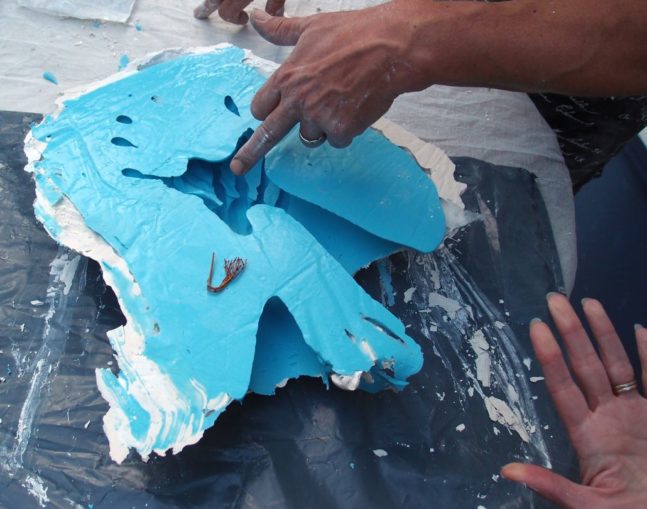
© SharpieType301 2013
Off to the workshop for stage three, and Tony carefully mixes the Jesmonite casting material in a bucket, adding the powder to the liquid and stirring to create a smooth slurry. From here things have to happen pretty quickly as, once mixed, the Jesmonite is fairly quick-setting and he only has around 20 minutes to work with it.

© SharpieType301 2013
Tony poured the first batch of the slurry into the mould, gently tilting it back and forth to ensure that the liquid penetrated every part of the mould. This first coating forms what will be the outer surface of the finished object. His concentration was intense, and he made sure any small bubbles that formed were broken so they wouldn’t mar the surface, obscuring the detail.

© SharpieType301 2013
Gradually, more and more Jesmonite was poured into the mould until it was completely full, with Tony pressing the thickening mixture into every crevice to ensure all cavities were filled to capacity. He then drew a straight edge across the top, smoothing the surface of the Jesmonite. As it began to ‘go off’ he used something which looked like a silicone kitchen spatula to build up the thicker wrist and forearm area. This may look a little rough for now, but he’s a sculptor, so he will tidy this and repair any small imperfections once the hands are set and removed from the mould. It was fascinating to watch him, and he wasn’t phased in the slightest by my incessant questions.
At this point I was actually able to get involved and help. This was getting really exciting now as I hadn’t expected to be part of the making. He lifted up the mould vertically, positioning it with the fingers pointing downwards toward the table. I held it in position, supporting it while he carefully built up the last section of the forearms.
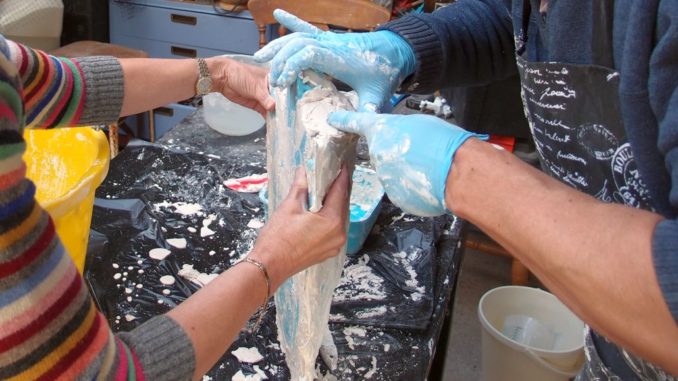
© SharpieType301 2013
Now came stage four, and this was scary as the first thing Tony did was get out a chisel and a saw! My heart skipped a beat, but he knows what he’s doing. This brutal toolkit was needed to get that protective plaster shell off the alginate mould so that this can be clearly seen, and then carefully peeled away from the cast hands. Once again, I could help, picking small chunks of plaster away from the blue mould. It took quite some time as the bandage, although useful, was a bugger to pull apart.

© SharpieType301 2013
Finally, with the plaster shell gone, the blue lump forming the back of the mould could be seen and, to be honest, it looked really odd—lumpy and misshapen. But now Tony could start gently peeling back the flexible alginate mould, cutting it away a piece at a time to begin to unveil the cast beneath it. It was amazing to see the details emerge step by careful step. We were entranced, and even Dawn and their dog braved the chilly workshop and came out to join us for the tantalising first glimpses of the hands.
I didn’t dare ‘help’ at this point. The most I was brave enough do was to support the cast and turn it so Tony could get to the the half-hidden areas of the blue alginate more easily. Slowly, more and more was revealed, then finally I could lift the hands in their entirety and see every tiny detail. That was a very special moment and there were big smiles all round.

© SharpieType301 2013
Tony explained that my long fingernails (which I’d grown specially for the occasion) had been just a little too much for the alginate to mould cleanly, so the tips appeared broken. No problem though, he would give the finished piece a manicure. He would also smooth the ends of the forearms to form an attractive shape, and take care of the inevitable imperfections from missed tiny bubbles present in the moulding or casting stages. For him to do this, and for the hands to set to their final hardness, would take a week or two, so we agreed that we’d return to pick up our new treasure another day. The anticipation was almost painful, and you, my dear Puffins, will have to wait for the story of the finished sculpture too.
To be continued…
© SharpieType301 2020
The Goodnight Vienna Audio file
Audio Player



